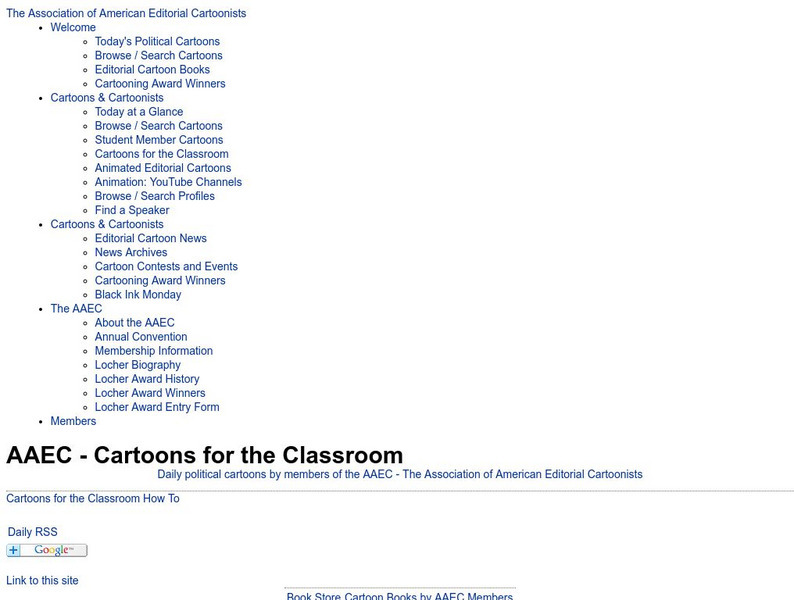Hi, what do you want to do?
Curated OER
Cartoon Analysis Worksheet
In this cartoon analysis worksheet, students fill out the worksheet to assist in the analysis of cartoons. They consider symbols when determining the message of the cartoon.
Curated OER
Smart Art
Learners examine and practice the art of political cartoon-making by focusing on how and why they are so effective in making a political point.
Curated OER
Political Protest Through Art
Learners examine how artists (painters or cartoonists) use artwork as a means of disseminating a political point of view in this lesson that uses primary source documents and examples of political cartoons.
Curated OER
Istanbul
Pupils explore the growing trade and tourist relationship between Greece and Turkey. They then research key event in Greco-Turkish history from each sides perspective to create political cartoons and a time line for classroom display.
Curated OER
Political Cartoons: Thinking Broadly, Communicating Succinctly
Students think broadly about the tsunami disaster and its aftermath through studying cartoons. Students critically think about the literary devices the authors/artists use, such as satire, metaphor and personification.
Curated OER
Make an Uncle Sam Folk Art Figure
Students create an Uncle Sam art figure. In this patriotic lesson, students use wood, paint, twigs, and glue to create a folk-art style figure of Uncle Sam.
Curated OER
Political Cartoons
Students analyze and interpret political cartoons, then use this knowledge to create their own.
Curated OER
Cartoons and Protest
Students examine political cartoons from 1774 through today, determine their meanings through analysis and discussion, and create their own political cartoons focusing on historical issues studied in class.
Curated OER
Political Cartoons: Literacy
Readers decode and deconstruct political cartoons to heighten critical thinking, extra-textual literacy, and making meaning from symbolism and metaphor. A compatible activity to use in English class when your 8th or 11th graders are...
Curated OER
Interpreting Primary Sources: Cartoons
In this analyzing primary sources worksheet, students examine 3 political cartoons of their choice and respond to 4 short answer questions regarding each of them.
Curated OER
Where's My Funny Paper?
Students identify main idea of passages, reading selections, and cartoons.
Curated OER
Interpreting Political Cartoons
Students review political cartoons and discuss what political impact they can have. They choose a current political cartoon and write an essay exploring its intent and impact.
Curated OER
Walt Disney
In this famous person worksheet, students read a passage about Walt Disney and then complete a variety of in-class and homework activities to support comprehension, including partner interviews, spelling, cloze, synonym...
Curated OER
Eng 312: Final Exam
When paired with other powerpoints by Don L.F. Nilsen, this final exam covers topics addressed throughout previous lectures (slide 14 specifies which lectures should be reviewed). Teachers could use this presentation to craft their own...
Curated OER
Restrictive and Nonrestrictive Clauses and Appositives
In this grammar worksheet, learners label each clause as restrictive or nonrestrictive, identify all appositives and add commas accordingly in eighteen sentences.
Curated OER
Junkyard Wars: Air Movers
Students study Rube Goldberg machines. For this investigative lesson students design and build a machine that uses several steps to move an aluminum can.
Curated OER
Creating a Classroom Magazine
Second graders examine different types of magazine writing, and discuss how to develop topics into information that is suitable for short magazine articles. They write, edit, and compose a monthly classroom magazine.
Curated OER
Toontime
Pupils examine and discuss how editorial cartoons are made and their role in society. They research and write about Andrew Jackson's presidency, and create an editorial cartoon of a modern presidency.
Curated OER
Political Cartoons: Symbols of Fear
Students brainstorm a list of reasons for fear, hate, and mistrust. They assess political cartoons for symbols, messages, and points of view. After researching cartoons, they choose one that best depicts fear or hatred and write...
Choices Program, Brown University
Choices: Teaching With the News: The Gulf Oil Disaster
Multi-media lesson plan includes a video, PowerPoint, and handouts from which students explore the issues raised by the 2010 Gulf of Mexico oil disaster and interpret political cartoons and the cartoonist's message.
ReadWriteThink
Read Write Think: Analyzing the Stylistic Choices of Political Cartoonists
Contains plans for four to five 50-minute lessons about analyzing political cartoons. In addition to student objectives and standards, these instructional plans contains links to PDF handouts and links to sites used in the lessons as...
Incredible Art Department
The Incredible Art Department: Incredible Artists
A massive collection of web links to artists categorized by art collections, cartoonists, black artists, female artists, male artists, ethnic artists, and native artists.
Newspapers in Education
Ni Eonline: Cartoons for the Classroom: Lessons Library
Newspapers in Education and the Association of American Editorial Cartoonists publish simple, inventive lesson plans and ideas for classes in editorial cartooning, caption writing, and news analysis. Lessons include "cartoon blanks" that...
Choices Program, Brown University
Choices: The United States in Afghanistan: Analyzing Political Cartoons
Using videos, handouts, and online resources, students explore viewpoints on the U.S. presence in Afghanistan, interpret political cartoons and place them in the context of a political discussion about Afghanistan, and identify the...


























